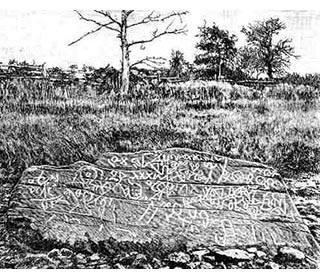Dighton Rock is estimated to be between 10,000 and 13,000 years old. Because of its age the origins of the rock can be authenticated and this had led to controversy and a series of theories regarding its origin. Facts about Dighton Rock
When Perhaps the first approach is to document what is known about Dighton Rock - the facts - Fact 1 - Age: Between 10,000 and 13,000 years old
- Fact 2 - First Report: The existence of Dighton Rock was first documented in 1690 when the Reverend Cotton Mather (who played a part in the Salem Witchcraft trials) described the rock in his one of his books, although he had never seen Dighton Rock
- Fact 3 - Approx size: 11 feet long and 5 feet high. Exact measurements: 5 feet (1.5 m) high, 9.5 feet (2.9 m) wide & 11 feet (3.4 m) long
- Fact 4 - Weight: 40 tons
- Fact 5 - Description: Slanted, six-sided block
- Fact 6 - Composition: Gray-brown crystalline sandstone
- Fact 7 - Original Location: in the riverbed of the Taunton River at Berkley, Massachusetts
- Fact 8 - Size of Surface: 55 square feet
- Fact 9 - When it was in the river bed Dighton Rock was covered by tidal water all but 4 hours each day. At high tide, the top of Dighton Rock was covered by 3-4 feet of water
- Fact 10 - Since 1680 over 1000 books and articles have been written about Dighton Rock
- Fact 11 - More than 20 theories have been proposed about its origins
- Fact 12 - Theories about its origins have linked the symbols on Dighton Rock with the Vikings, the Phoenicians, the Portuguese and the Native American Indians
- Fact 13 - In 1963 Dighton rock was removed from the river for preservation
- Fact 14 - Dighton Rock is now in a museum in Dighton Rock State Park
- Fact 15 - In 1980 it was listed on the National Register of Historic Places
- Fact 16 - No one knows where Dighton Rock originated and who was responsible for the carvings of its symbols
Dighton Rock - Drawing by John Danforth
In 1680, the English colonist Reverend John Danforth, made a drawing of the Petroglyphs inscribed on Dighton Rock. In 1732, the Royal Society of London requested and received Danforth’s drawing of Dighton Rock. The Danforth drawing was later presented to the British Museum where it is preserved today. |
